HOME
Istanbul

This is one of two suspension bridges that links European Istanbul to Asian Istanbul.
This city stands between the two continents, between the occident and the orient, and
spans western history from today back to Alexander the Great.
 This monolith was stolen from Egypt by the Romans and set up as a spinnerette in the
hippodrome in the 300s. This single piece of granite was cut and carved over
3,500 years ago. Half of it was lost when it broke in two during transport.
This monolith was stolen from Egypt by the Romans and set up as a spinnerette in the
hippodrome in the 300s. This single piece of granite was cut and carved over
3,500 years ago. Half of it was lost when it broke in two during transport.
Mosques are everywhere in Istanbul, 2,300 of them.


Sultanahmet imperial mosque, commonly
known as the blue mosque, is the most famous
but ...
it is Sulemaniye imperial mosque that dominates the skyline.

Ancient Christian churches are also a part of Istanbul's
famous structures.
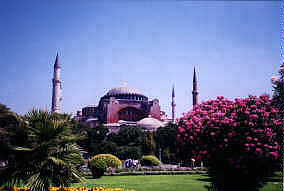
St. Sofia was constructed in the 300s by Constantine and reconstructed by
Justinian in the 500s. It was the
principal church of the Christian world for over a 1,000 years.
Like most churches, it was converted to a mosque after the
Ottoman Empire was established.
Constantinople fell to the
Turks in the mid 1400s. Even so, Istanbul remains the Patriarchate of
the Eastern Church (Greek Orthodox).
 The Chora or Kariye church (now a museum) was originally built by Theodus in the early
500s
in the reign of Justinian. In the 11th and 12th century, it was rebuilt and
dedicated to Christ the Savior.
The Chora or Kariye church (now a museum) was originally built by Theodus in the early
500s
in the reign of Justinian. In the 11th and 12th century, it was rebuilt and
dedicated to Christ the Savior.
It too was converted into a mosque in the early 1500s.
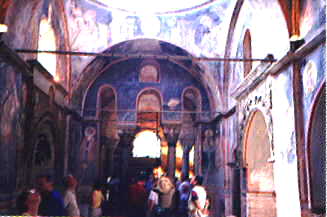 Its interior is completely decorated with mosaics and frescoes depicting the
scripture stories, and portraying many Byzantine icons.
Its interior is completely decorated with mosaics and frescoes depicting the
scripture stories, and portraying many Byzantine icons.
The moslems did not destroy the church decor, but plastered over it.
After the Turkish Republic was established many of the churches were
opened as museums, with much of the art work restored.




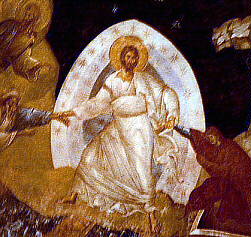
 This is the gate to Topkapi Palace. It was the imperial palace of the Ottoman sultans.
This is the gate to Topkapi Palace. It was the imperial palace of the Ottoman sultans.
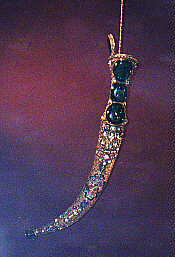
It contains many treasures of the Sultans.
It also is the repository of relics
of the Prophet Mohammed and by a strange quirk of history,

John the Baptist;
(His right arm, and a piece of his skull).
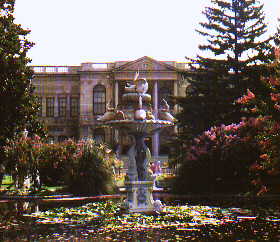 Dolmabahche Palace was built in the 1800s. It was the last
palace of the Ottoman Empire that stretched from the Balkans
to Arabia.
Dolmabahche Palace was built in the 1800s. It was the last
palace of the Ottoman Empire that stretched from the Balkans
to Arabia.
 It is finely decorated in traditional moslem art-work and grand
furnishings, including a chandelier weighing 4 1/2 tons.
It is finely decorated in traditional moslem art-work and grand
furnishings, including a chandelier weighing 4 1/2 tons.
To compliment its fascinating history, Istanbul is a modern and
cosmopolitan city.
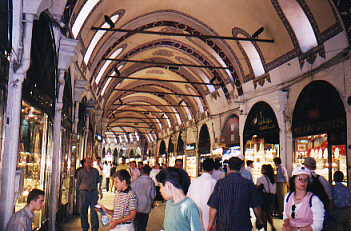
The Kapali bazaar (Covered bazaar) has a distinctive asian
flavor, but is a modern "shopping mall" that would delight
the most jaded shopper. It has over 4,000 shops to explore.
Return to Places we visited.
Go To Eclipse.
Return to Turkey Adventures.

 This monolith was stolen from Egypt by the Romans and set up as a spinnerette in the
hippodrome in the 300s. This single piece of granite was cut and carved over
3,500 years ago. Half of it was lost when it broke in two during transport.
This monolith was stolen from Egypt by the Romans and set up as a spinnerette in the
hippodrome in the 300s. This single piece of granite was cut and carved over
3,500 years ago. Half of it was lost when it broke in two during transport.




 The Chora or Kariye church (now a museum) was originally built by Theodus in the early
500s
in the reign of Justinian. In the 11th and 12th century, it was rebuilt and
dedicated to Christ the Savior.
The Chora or Kariye church (now a museum) was originally built by Theodus in the early
500s
in the reign of Justinian. In the 11th and 12th century, it was rebuilt and
dedicated to Christ the Savior.
 Its interior is completely decorated with mosaics and frescoes depicting the
scripture stories, and portraying many Byzantine icons.
Its interior is completely decorated with mosaics and frescoes depicting the
scripture stories, and portraying many Byzantine icons.



 This is the gate to Topkapi Palace. It was the imperial palace of the Ottoman sultans.
This is the gate to Topkapi Palace. It was the imperial palace of the Ottoman sultans.


 Dolmabahche Palace was built in the 1800s. It was the last
palace of the Ottoman Empire that stretched from the Balkans
to Arabia.
Dolmabahche Palace was built in the 1800s. It was the last
palace of the Ottoman Empire that stretched from the Balkans
to Arabia.
 It is finely decorated in traditional moslem art-work and grand
furnishings, including a chandelier weighing 4 1/2 tons.
It is finely decorated in traditional moslem art-work and grand
furnishings, including a chandelier weighing 4 1/2 tons.
